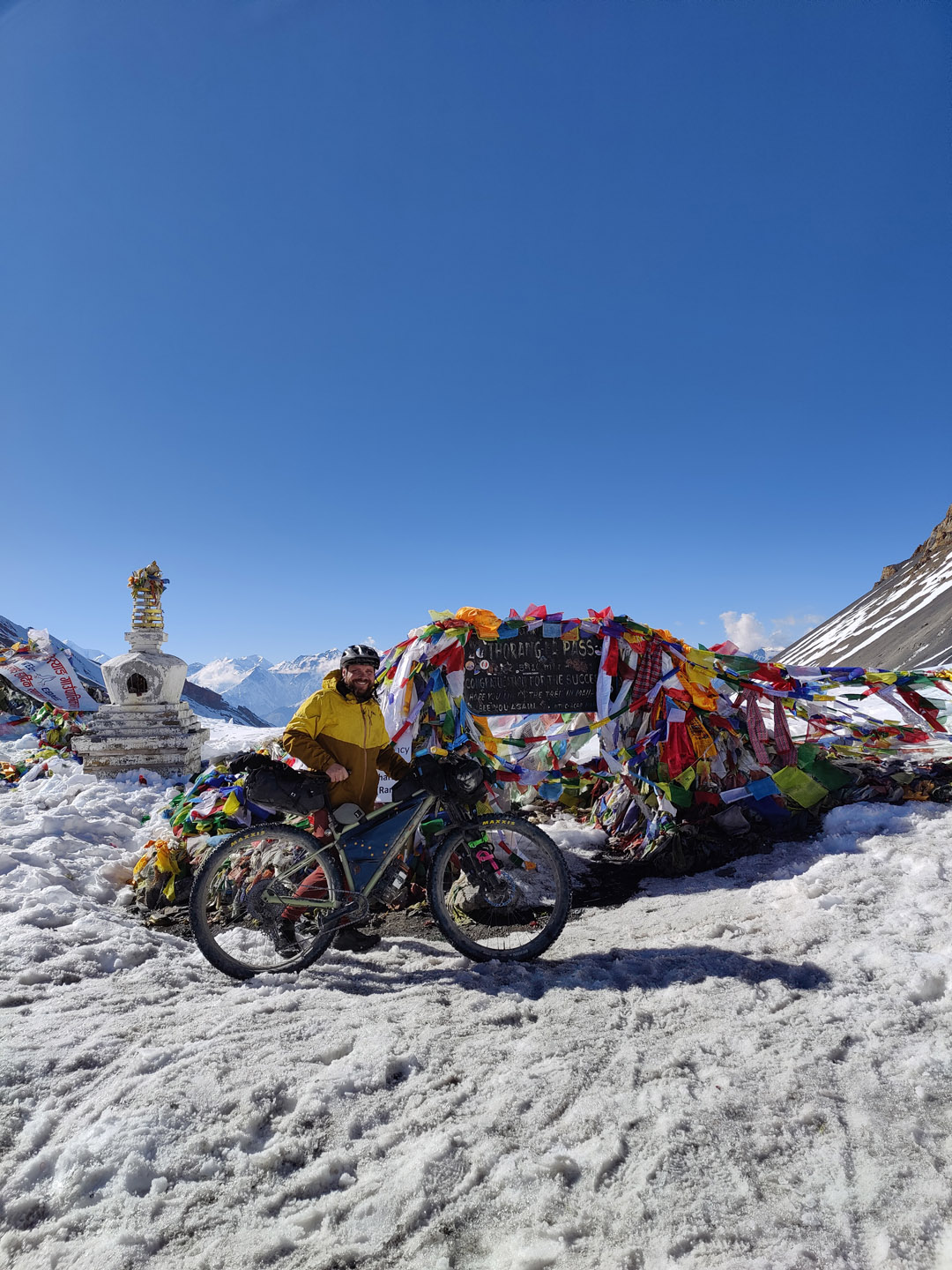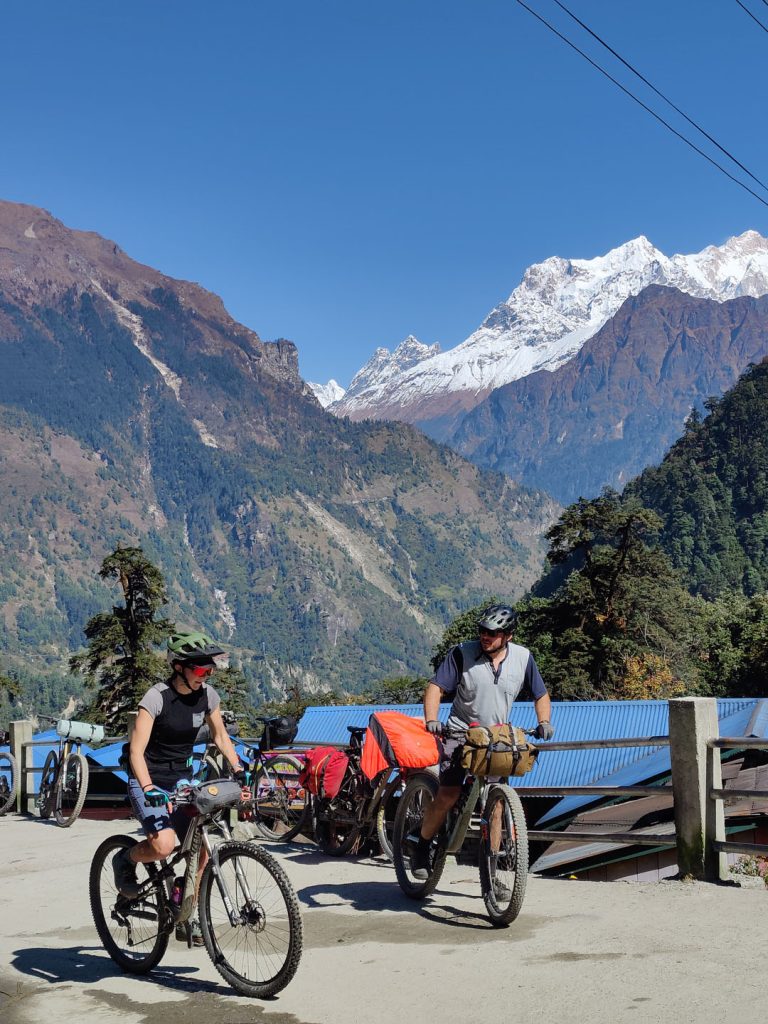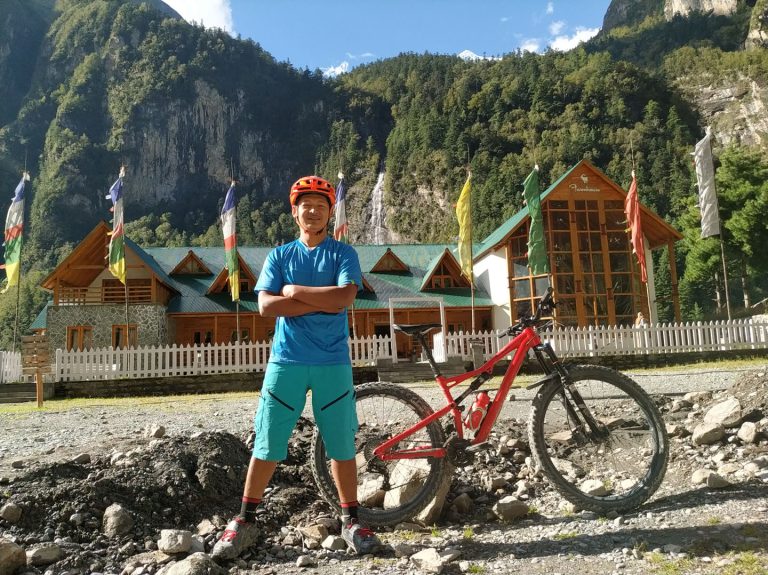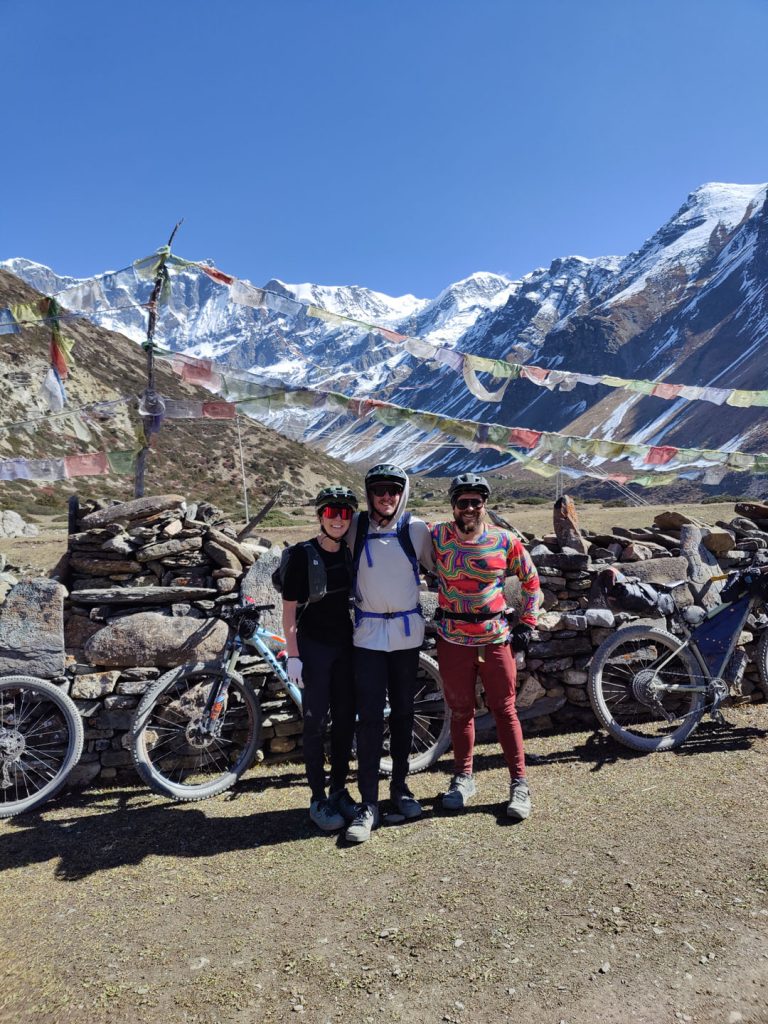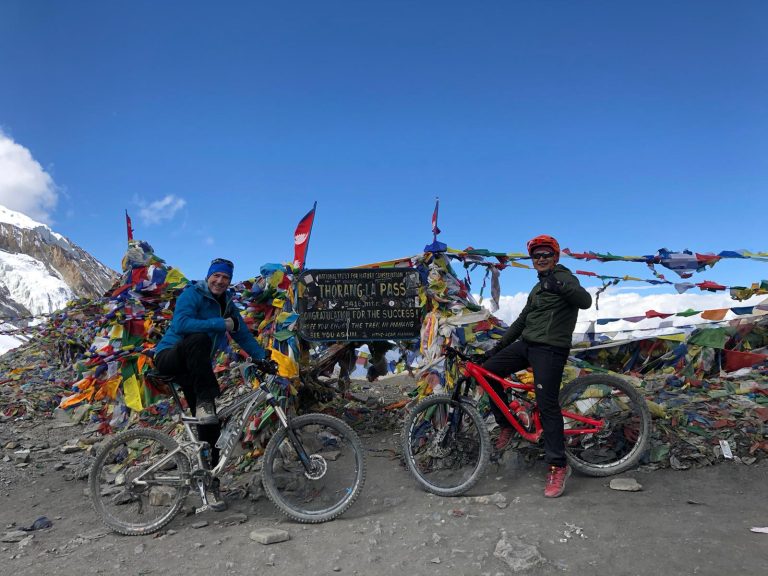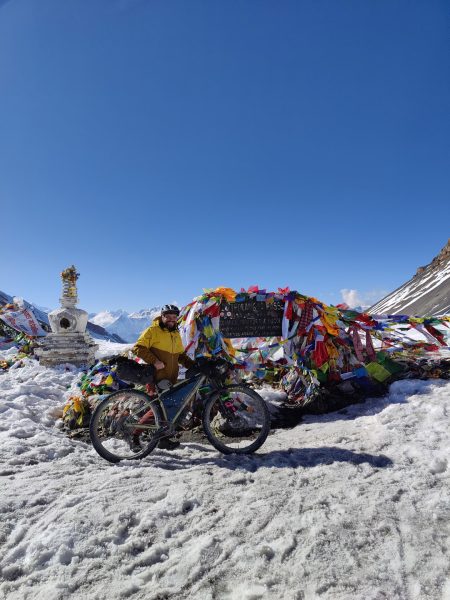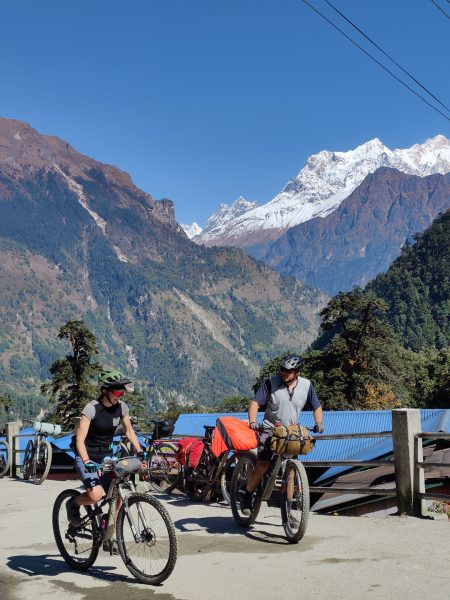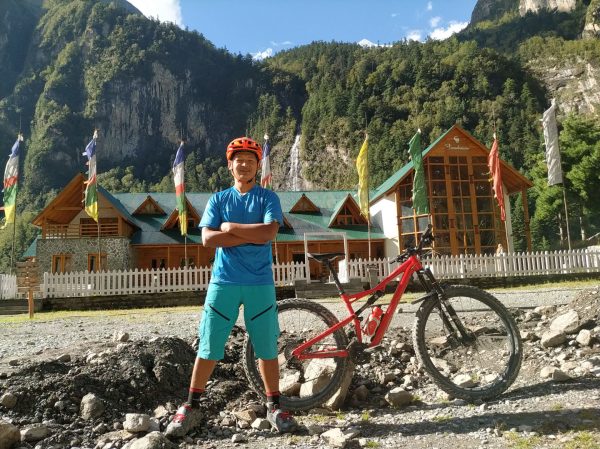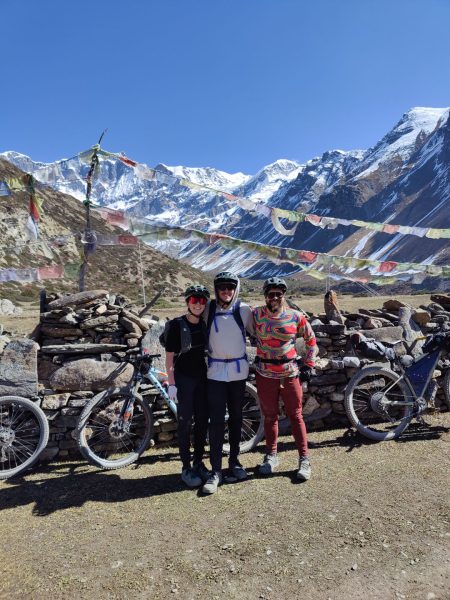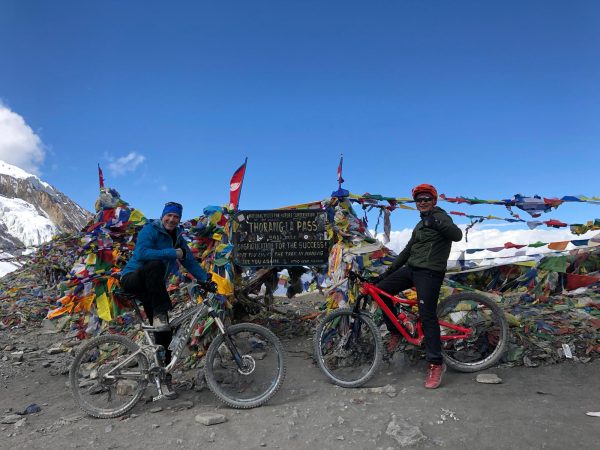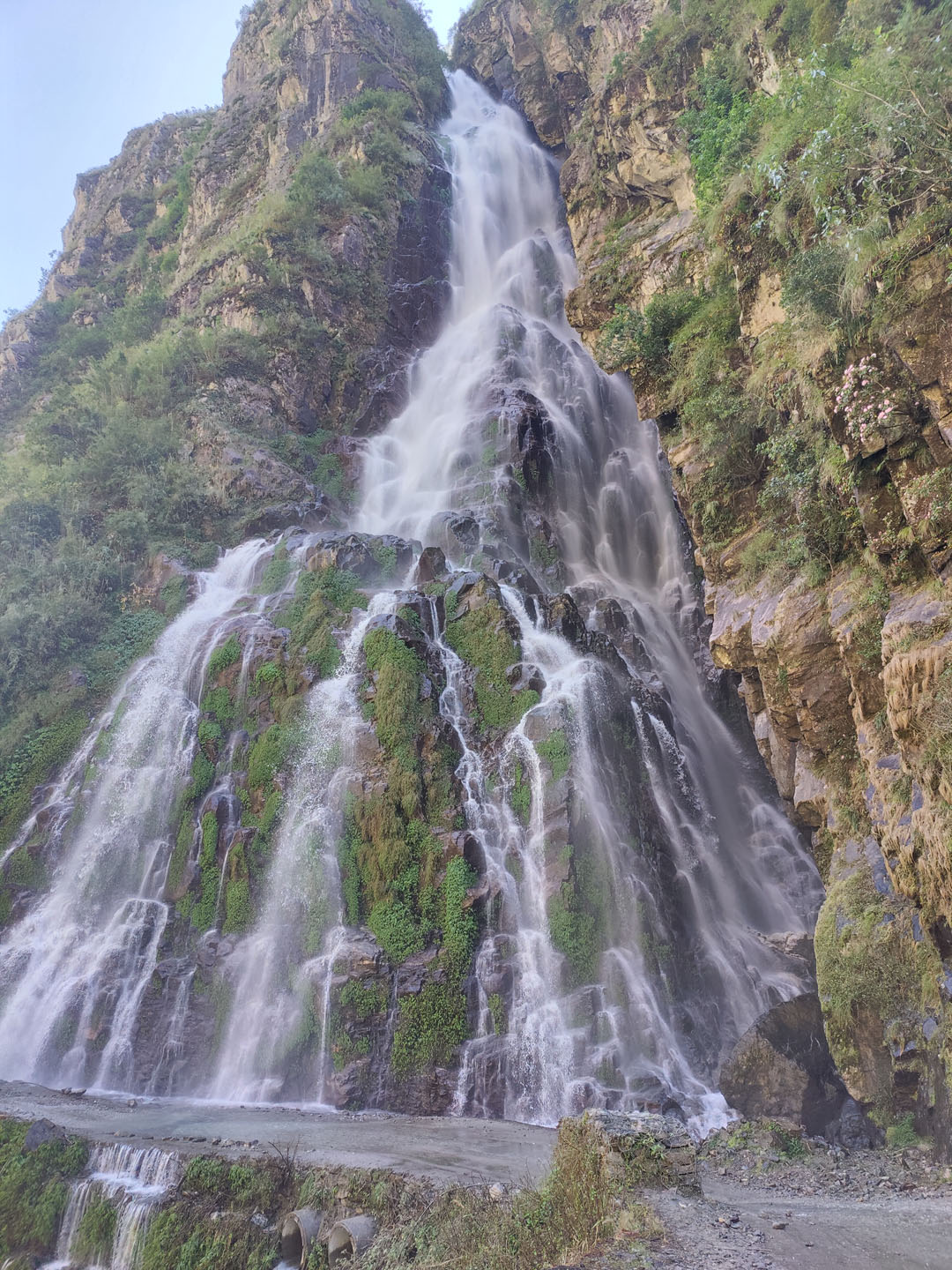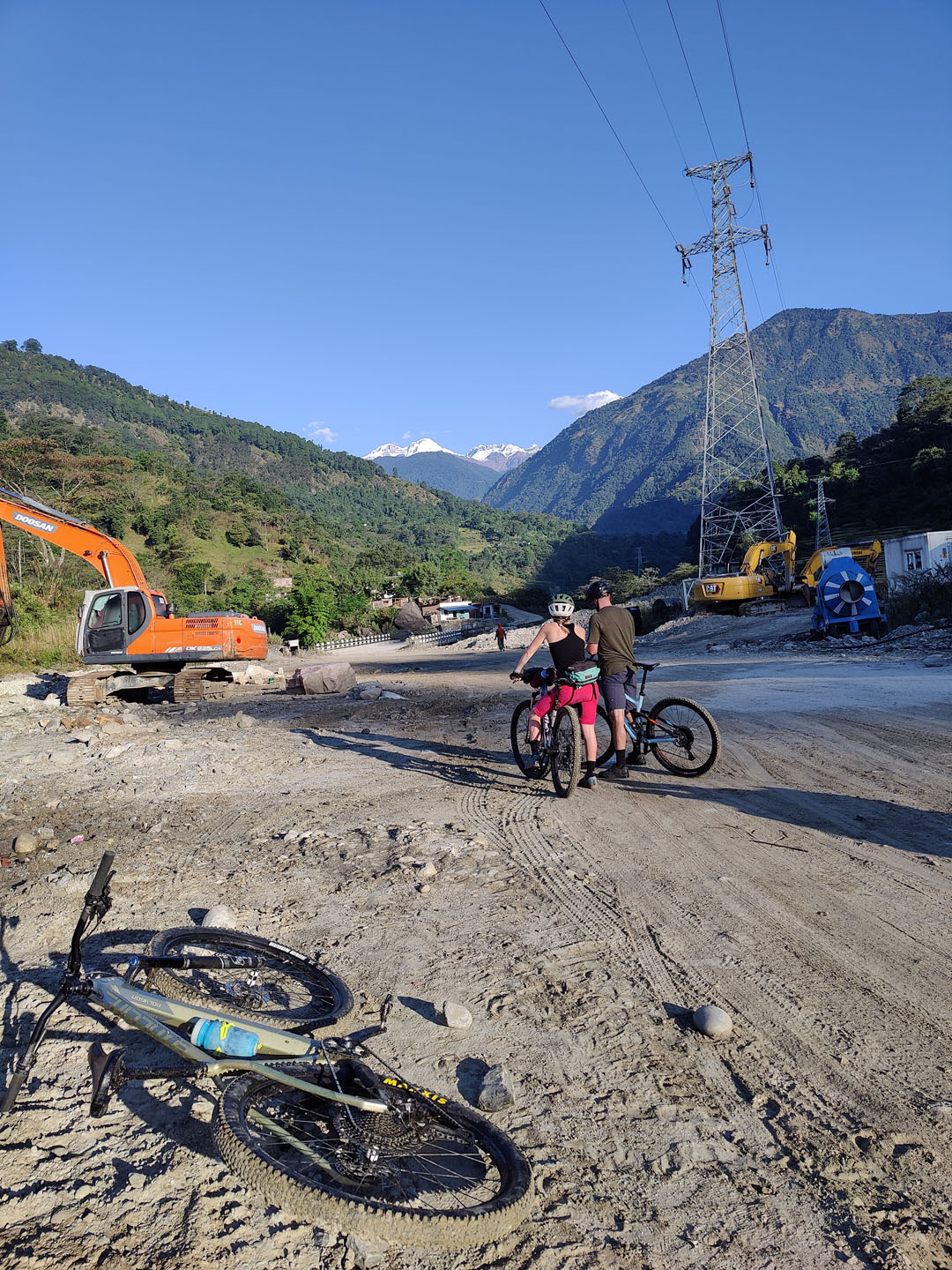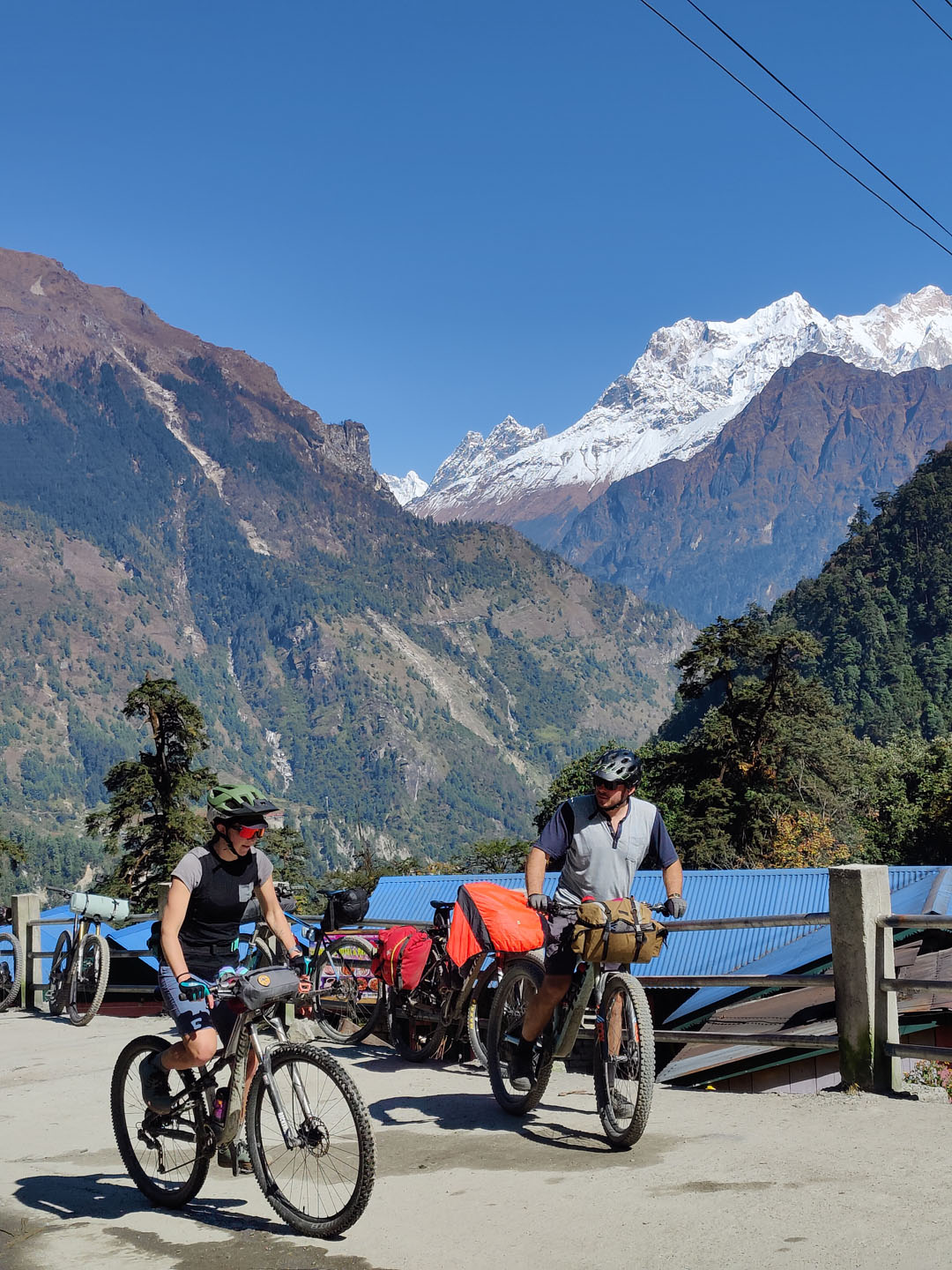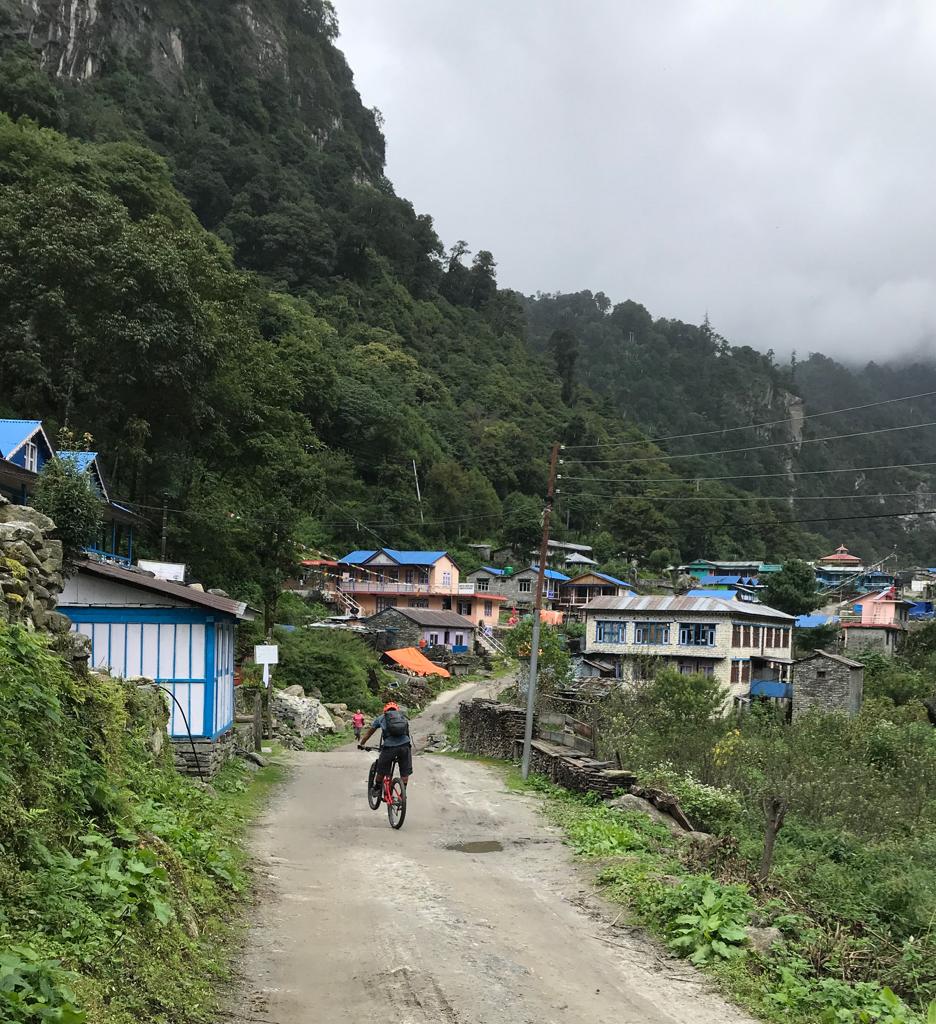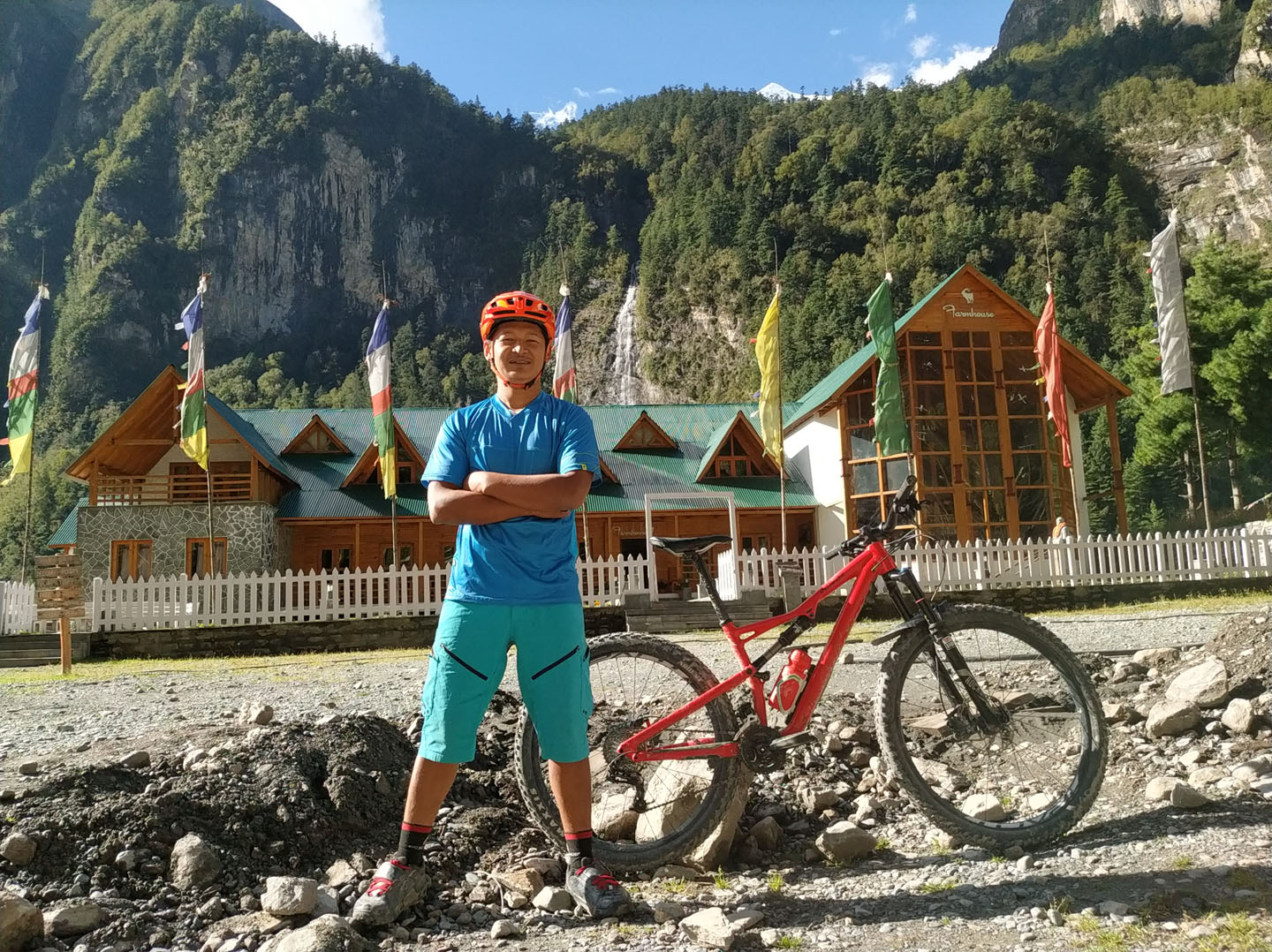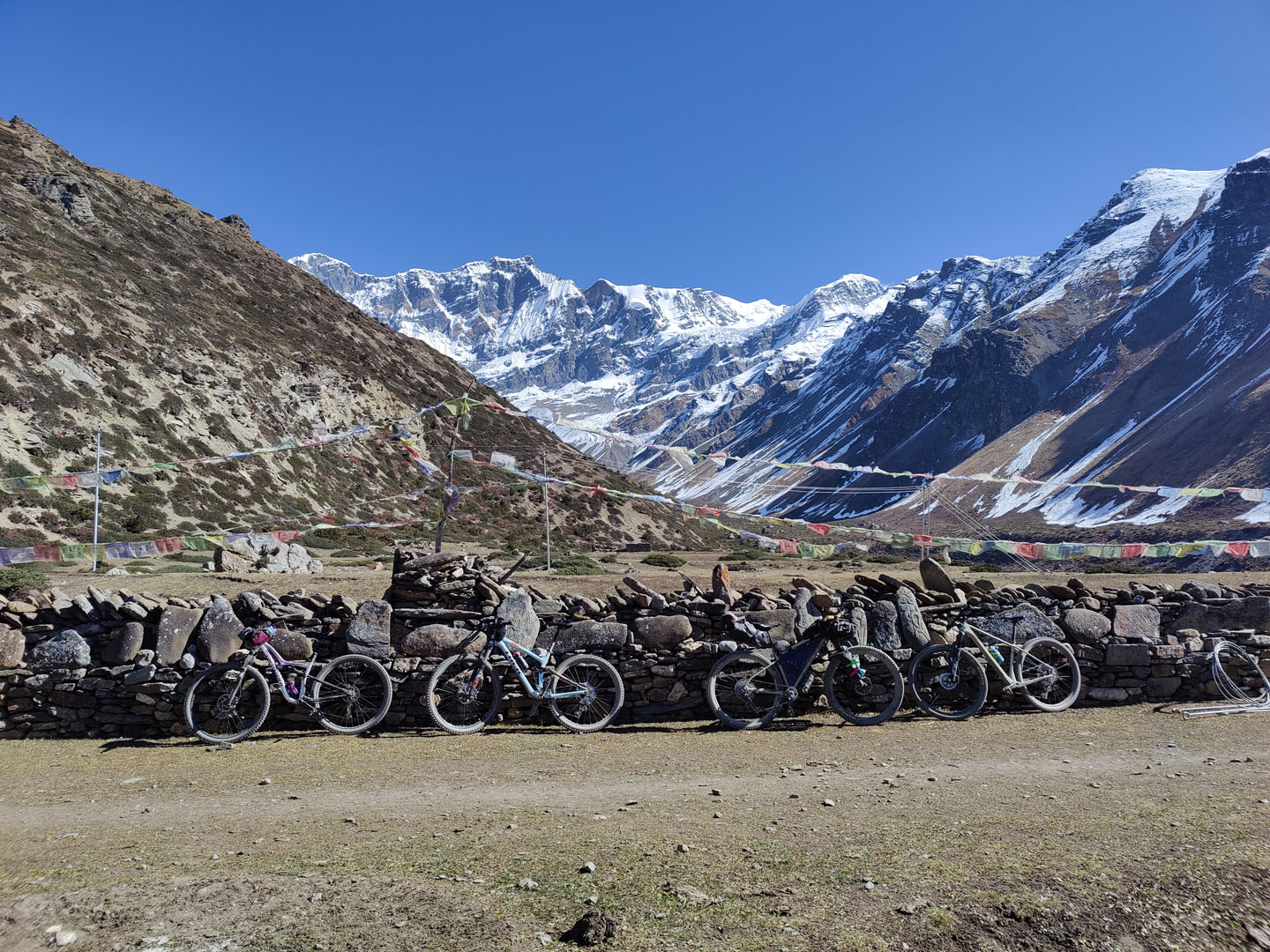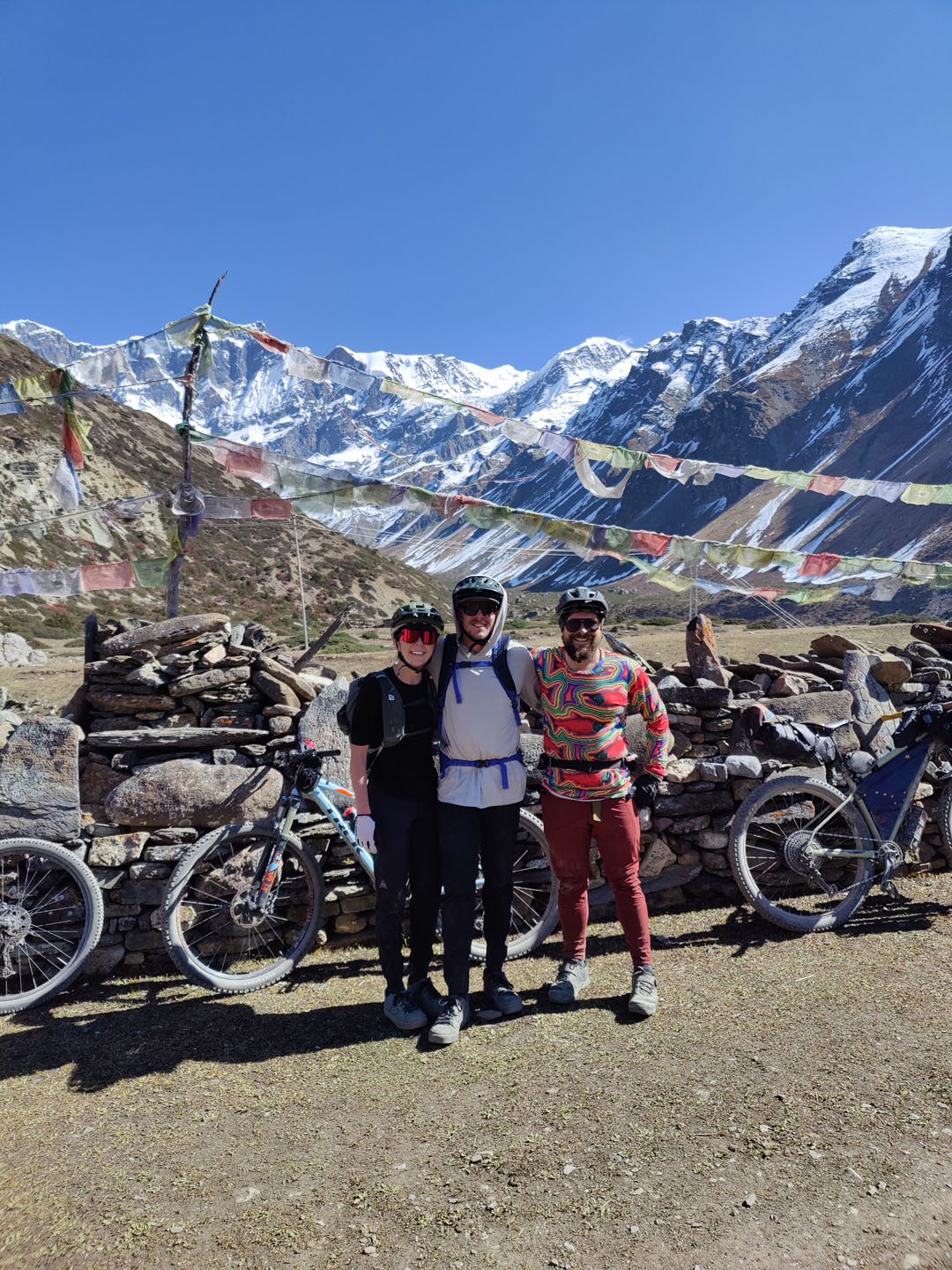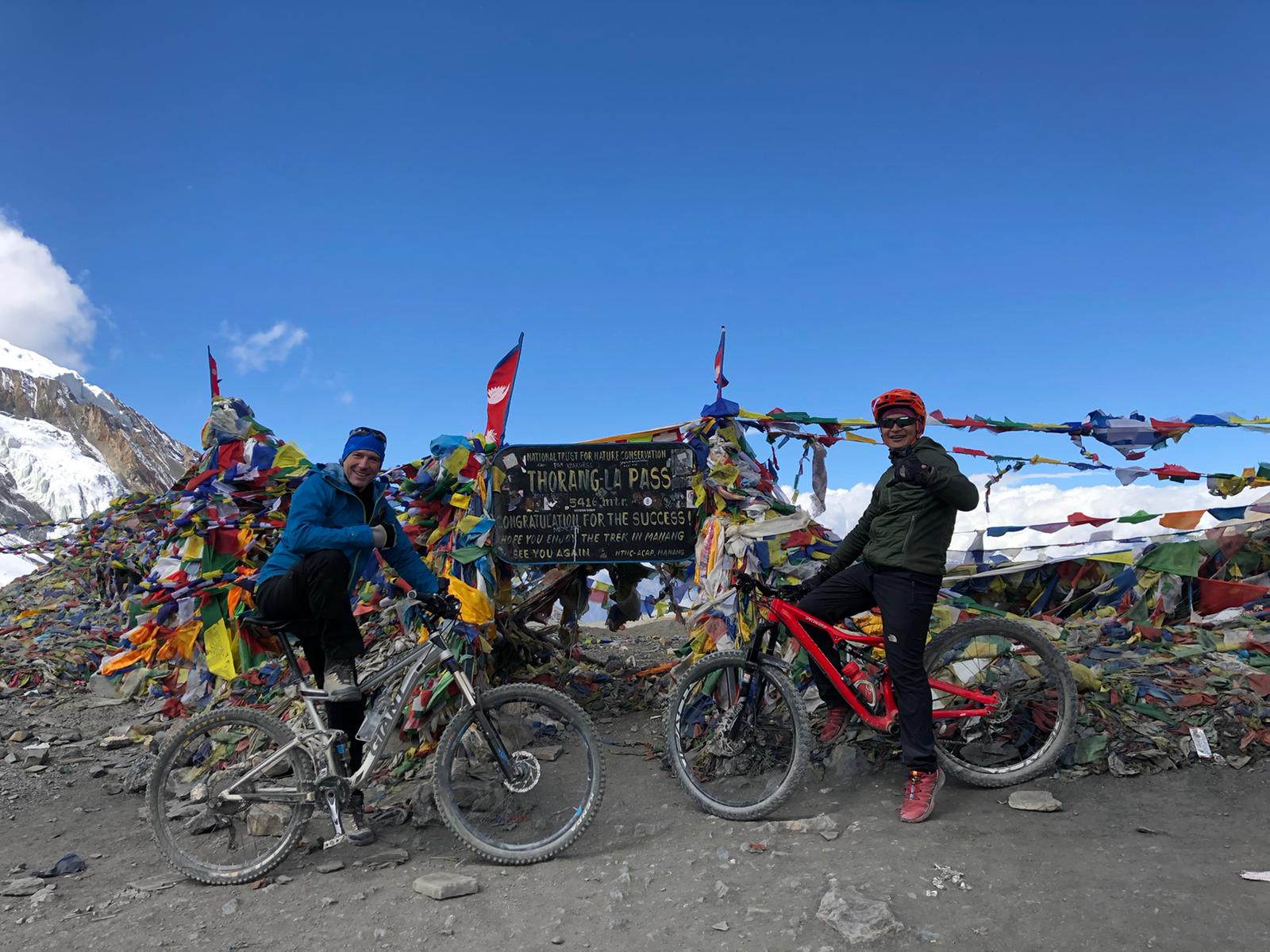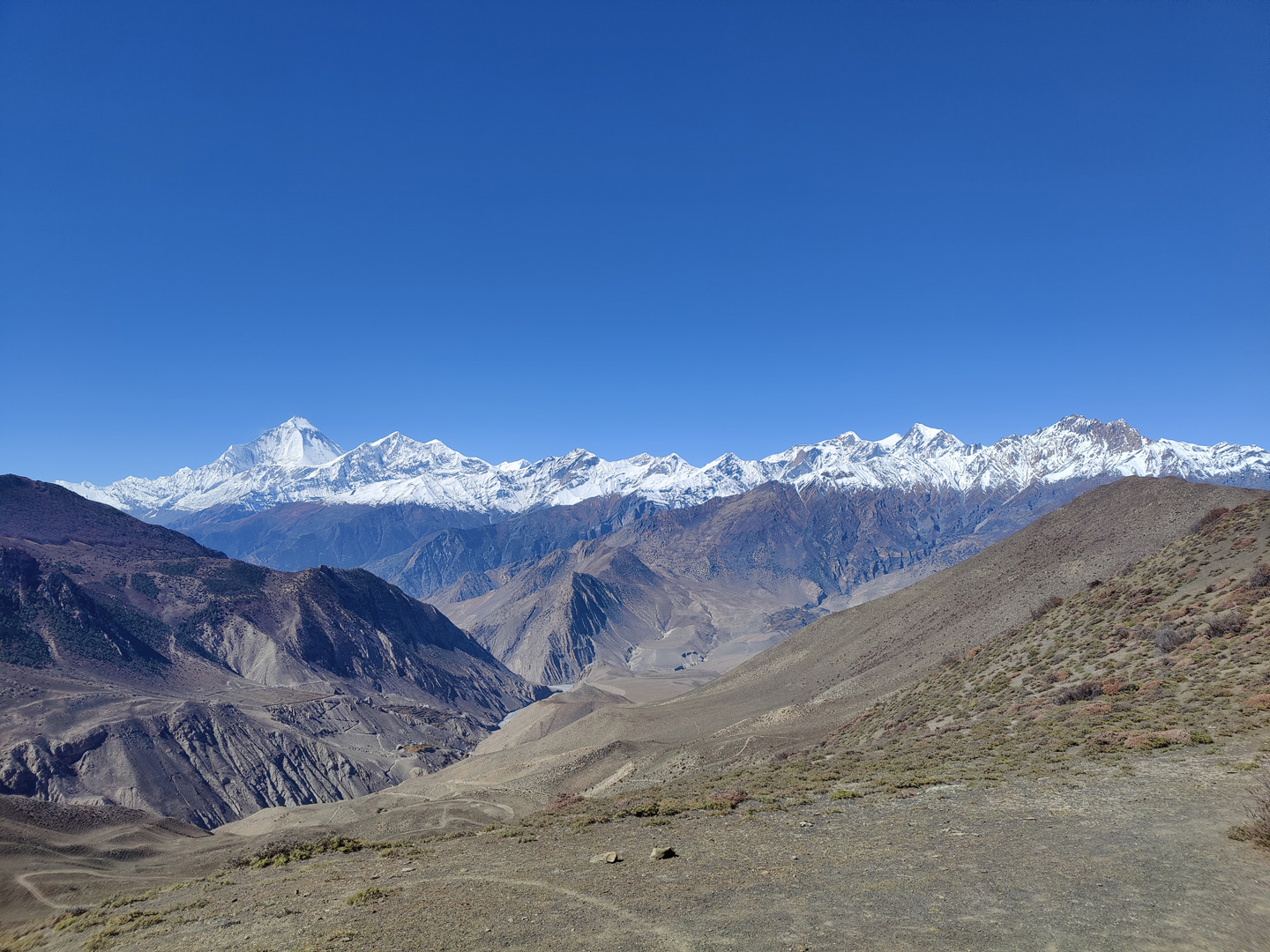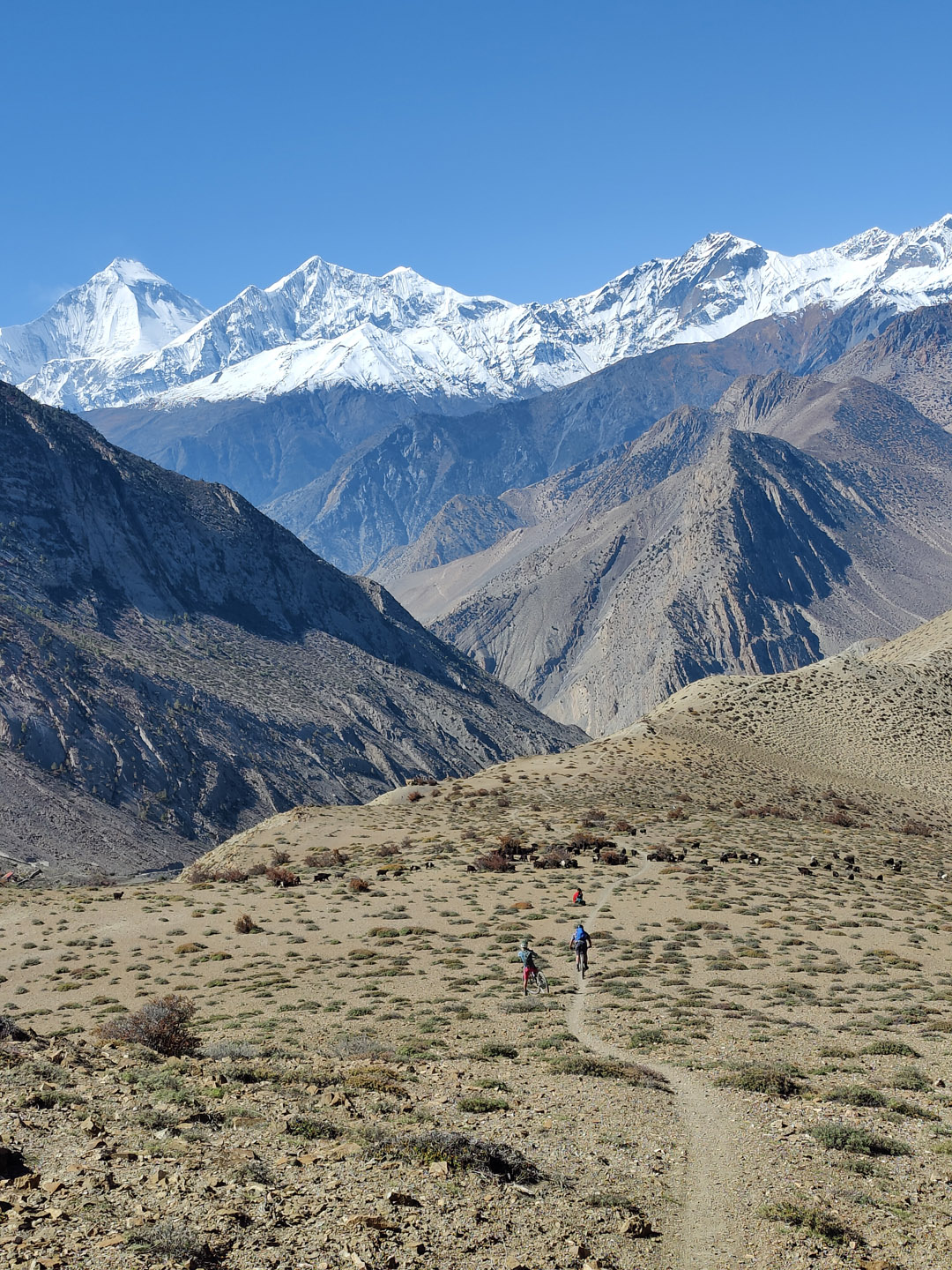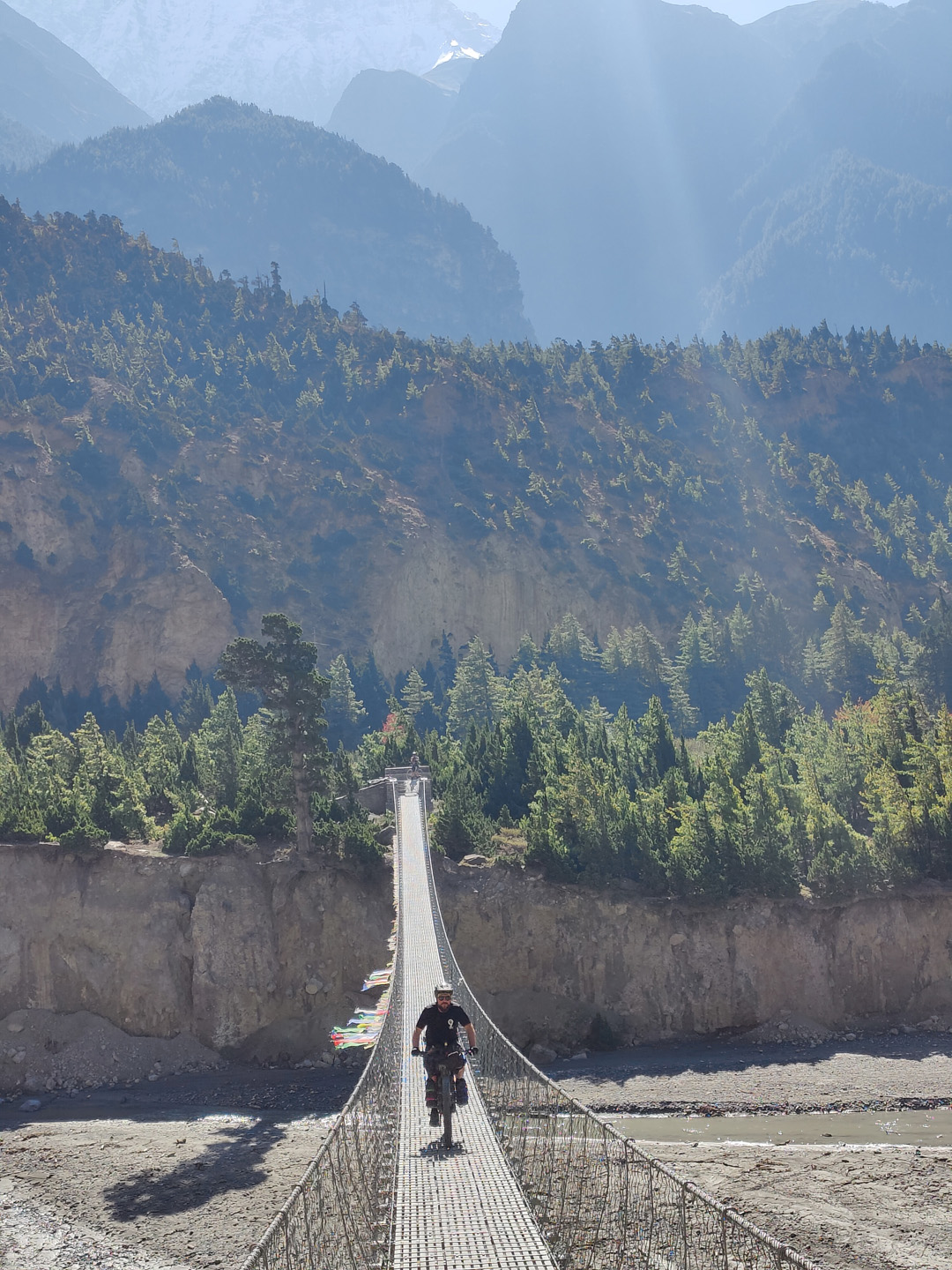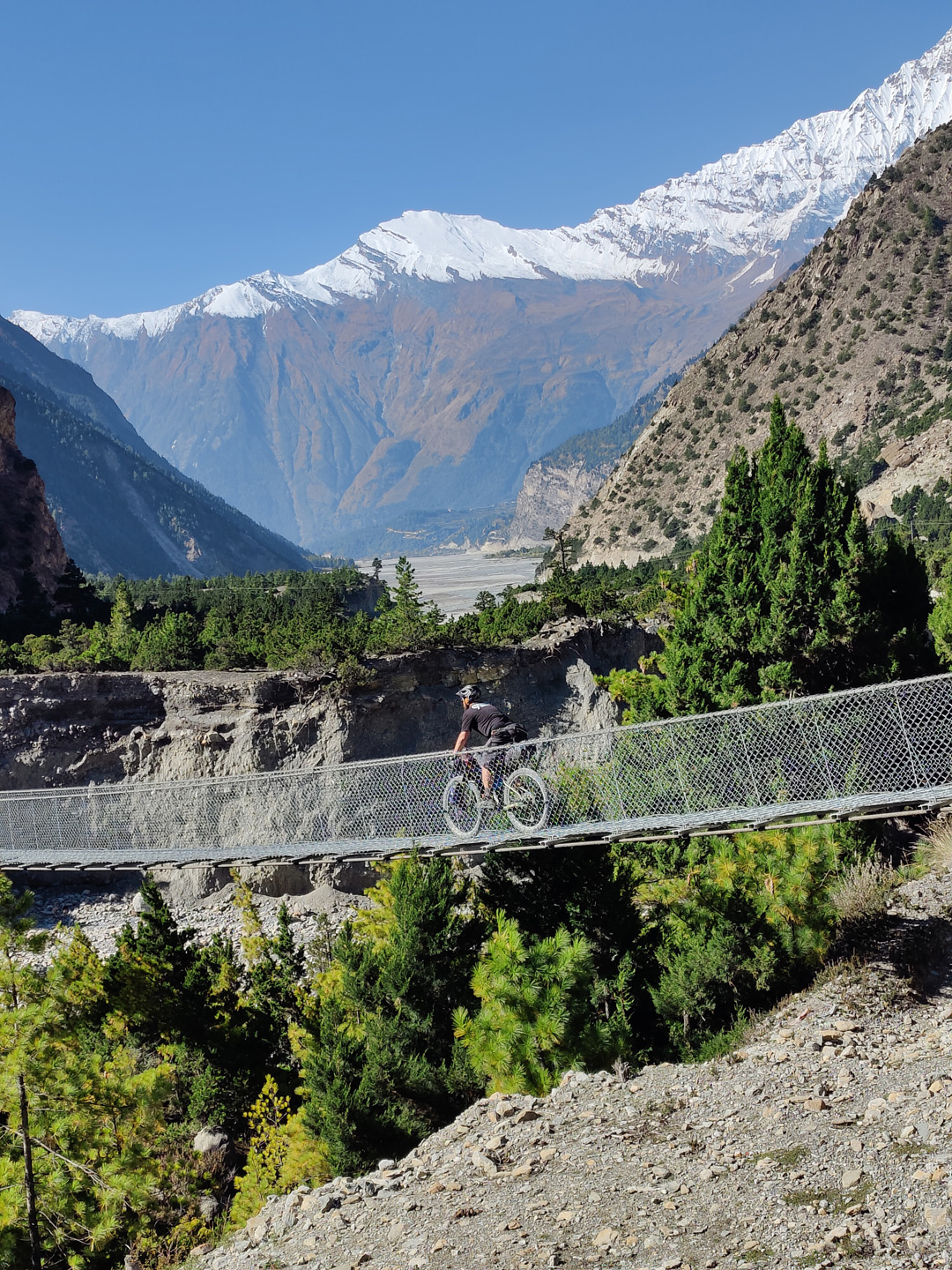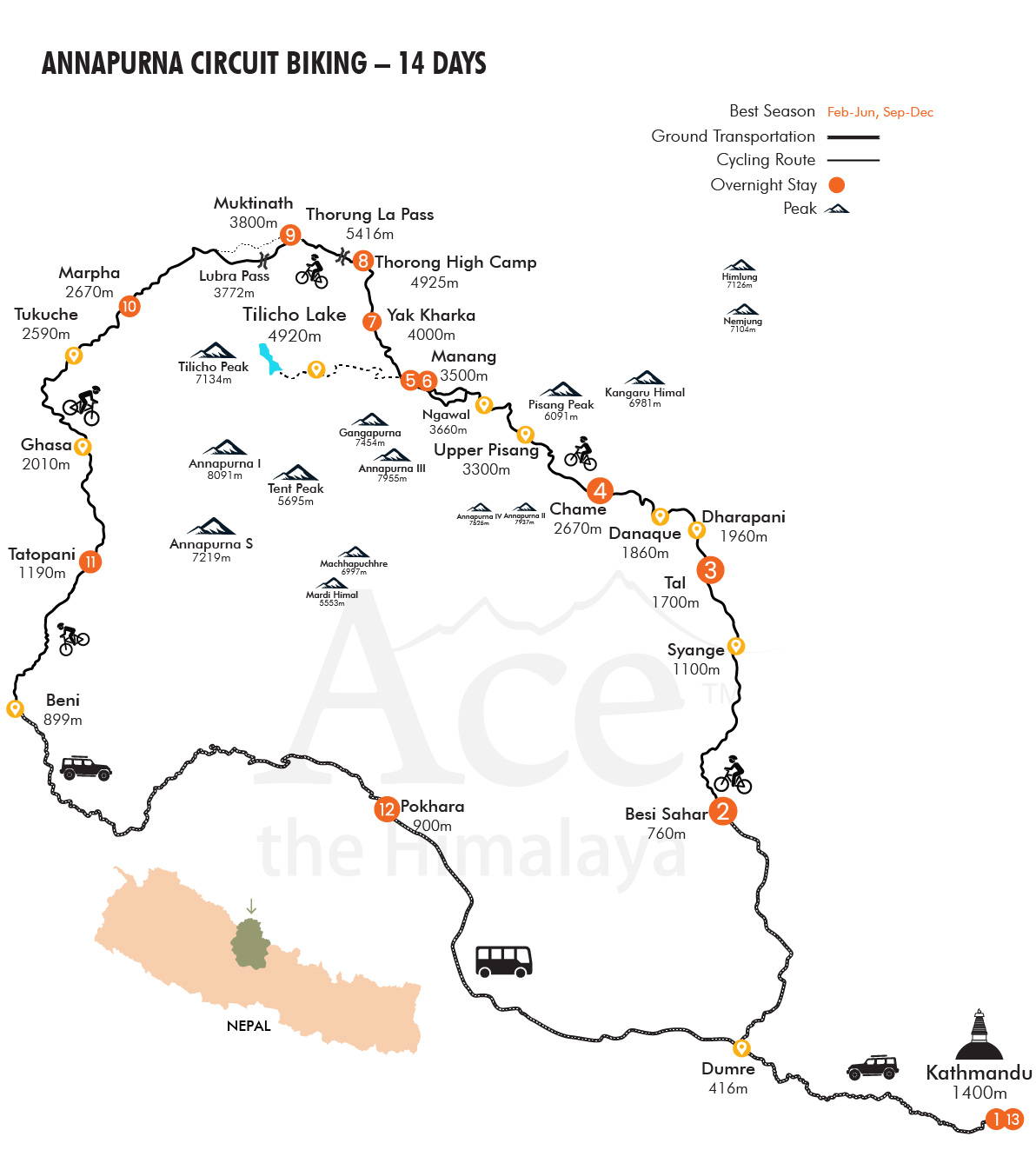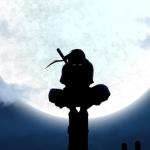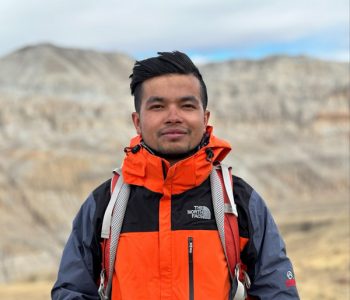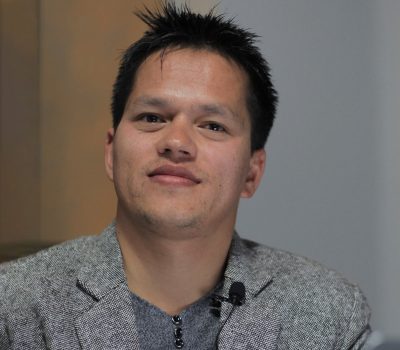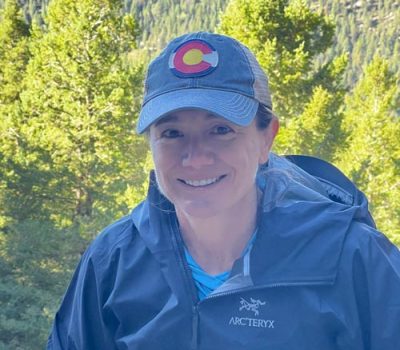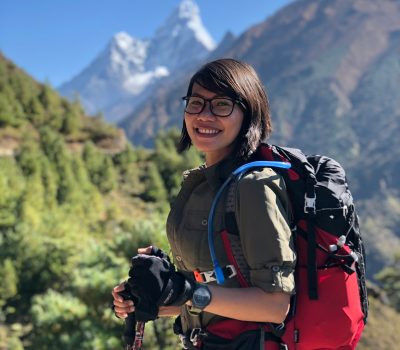Annapurna Circuit Biking - 14 Days
Hop onto hot tyres for this extraordinary trip takes you to some of the most stunning and exotic biking routes in Nepal.
Trip Highlights
- Crossing the Thorong La Pass at 5,416 m on wheels.
- Riding along the popular trails of the Annapurna Circuit.
- Tasting the renowned apples, apple pie, and apple wine in Jomsom.
- Sightseeing in Muktinath and exploring the popular hiking routes in the area.
- Bathing in natural hot springs at Tatopani.
Trip Overview
This extraordinary Annapurna Circuit Biking trip takes you to some of the most stunning and exotic biking routes in Nepal. Annapurna Circuit biking tour passes through a variety of different landscapes, from the lush sub-tropical rainforests, deep valleys, and cultivated fields, to wooded alpine and high deserts. Visit many different villages, meet the local hill communities, and enjoy frequent spectacular views of massive Himalayan peaks, including Annapurnas and Manaslu.
Reach the lowland villages, dense oak forests, deep gorges, and lovely isolated hamlets to the lap of the mighty high mountains and the Gangapurna Lake – one of the beautiful altitude freshwater lakes. To top it all, the crossing of the Thorong La Pass (5,416 m) is a challenging ascent, surrounded by some of the most magnificent mountain sceneries in the world.
Begin your mountain biking trip after driving from Kathmandu to Besisahar via ground transportation. This is the starting point of biking (and also that of trekking). From here begin biking anti-clockwise around the Annapurna massif. The trail climbs gradually, allowing you to acclimatize to the high altitudes, as you travel along the Marsyangdi Valley.
After the crossing of the Thorong La Pass, descend to Muktinath, one of the most important Hindu pilgrimage sites. From here, cross Lupra Valley to reach Jomsom, and then descend down to Tukuche, Tatopani, and finally to Beni where your biking ends. A jeep will transfer you to Pokhara and the next day return to Kathmandu.
As demanding as the rugged terrain and technical tracks are this Annapurna Circuit Biking trip is designed for more experienced riders and is not recommended for beginners. It will be grueling but surely worth every drop of sweat.
Short Itinerary
Arrive at Tribhuvan International Airport in Kathmandu (1,400 m) and transfer to the hotel. Overnight at a hotel.
Pre-Biking Meeting and Drive to Besisahar (760 m) from Kathmandu – 5 to 6 hours. Overnight at a guesthouse.
Ride to Tal (1,700 m) from Besisahar. Distance: 38 km – 7 to 8 hours. Overnight at a guesthouse.
Ride to Chame (2,670 m) from Tal. Distance: 23 km – 6 to 7 hours. Overnight at a guesthouse.
Ride to Manang (3,540 m) from Chame. Distance: 30 km – 6 to 7 hours. Overnight at a guesthouse.
Acclimatization Day at Manang Village and Visit to Gangapurna Lake and Glacier. Overnight at a guesthouse.
Ride to Yak Kharka (4,050 m) from Manang. Distance: 19 km – 3 to 4 hours. Overnight at a guesthouse.
Ride to Thorong High Camp (4,925 m) from Yak Kharka via Thorong Phedi (4,450 m). Distance: 12 km – 4 to 5 hours. Overnight at a guesthouse.
Ride to Muktinath (3,760 m) from Thorong High Camp via Thorong La Pass (5,416 m). Distance: 20 km – 7 to 8 hours. Overnight at a guesthouse.
Ride to Marpha (2,670 m) from Muktinath via Lupra Valley. Distance: 32 km – 6 to 7 hours. Overnight at a guesthouse.
Ride to Tatopani (1,190 m) from Marpha. Distance: 42 km – 5 to 6 hours. Overnight at a guesthouse.
Ride to Beni (899 m) from Tatopani. Distance: 25 km – 3 to 4 hours ride and same day drive to Pokhara (900 m) by Private Tourist Vehicle – 4 to 6 hours. Overnight at a hotel.
Drive to Kathmandu by a private tourist vehicle – 5 to 7 hours (including the lunch break). Overnight at a hotel.
Transfer to the International Airport for Your Final Departure.
 Note
Note
Our standard itinerary might differ slightly due to unpredictable happenings and events out of our control. Factors such as flight cancellation/delay, unfavorable weather, natural calamities, newly implemented government rules, political affairs, health conditions, etc., are possible. Evaluating the situation’s possible solutions allow the trekking to resume as much as possible based on the best alternatives. In these times, we look for your cooperation and flexibility.
It is advised you arrive a day before the trip starts, so you can rest and it also gives you time to buy clothing equipment, and gear required for the trip. Also, it is best if you book your international flights with spare days in Nepal before and after your trip in case of any flight delays or cancellations due to weather. Moreover, you have options to customize this trip where you can add on a sightseeing tour in Kathmandu, Pokhara, other adventure sports or day trips around the country before or after the trip.
Departures & Availability
Our groups are small with maximum 14 people. We create groups of independent travelers, friends and families which maintains close interpersonal connection, engage more and get into depth of the journey. The featured departures are guaranteed to run, so book now and secure your place.
Our groups are small with maximum 14 people. We create groups of independent travelers, friends and families which maintains close interpersonal connection, engage more and get into depth of the journey. The featured departures are guaranteed to run, so book now and secure your place.
Looking for personalized experience? We organize privately guided journey which is mainly designed to fit your taste and interest. We allow complete flexibility on your departure date, please choose your preferable date.
Price Includes
Accommodation
- Twin-sharing/double accommodation in a 3-star hotel in Kathmandu and Pokhara for 1 night each including breakfast (Private room accommodation can be organized at an extra cost).
- Twin-sharing guesthouse accommodation during the biking in the Annapurna region for 11 nights.
Meals & Drinking Water
- A farewell dinner on the last night in Nepal
- Purified drinking water during the trek using Water Filter or water purification tablets.
Transportation
- All (international and domestic) airport transfers on a tourist vehicle
- Ground transportation from Kathmandu to Besisahar, Beni to Pokhara, and from Pokhara to Kathmandu in a Private tourist vehicle.
Guide and Staff
- Experienced, first-aid trained, government licensed, English-speaking Ace the Himalaya’s biking guide (The number of guides and assistant guides differs according to the group size).
- Porters during the trip for carrying your luggage (1 porter for every 2 clients).
- Wages, accommodation, meals, gear, insurance, and medications for all staff
Permits
- Annapurna Conservation Area Permit
- TIMS (Trekkers’ Information Management System) card
Benefits and Takeaways
- 1 Ace the Himalaya’s duffel/kit bag, trekking map, sun hat, Buff (Neck Gaiter)
- Trip completion certificate
Administrative & Taxes
- All administrative expenses and government taxes
Price Excludes
- Mountain Bike. You can hire a full-suspension mountain bike for USD 60 to USD 75 per bike per day.
- Meals (lunch & dinner) in Kathmandu and Pokhara and (breakfast, lunch, and dinner) during biking in the Annapurna region.
- International flight fare and airport departure tax
- Any beverages including bottled and boiled water
- Travel insurance along with high-altitude emergency evacuation coverage
- Tips to biking staff and driver (Tipping is expected).
- Nepal Entry Visa (Visa can be acquired easily after your arrival at Tribhuvan International Airport in Kathmandu with a fee of USD 30 for 15 days visa, USD 50 for 30 days visa and USD 125 for 90 days visa)
- Biking attire and other personal gears.
- Any expenses other than the Price Include section
Detailed Itinerary
Expand AllDay 01: Arrive at International Airport in Kathmandu and transfer to the hotel
Our airport representative will receive you at Tribhuvan International Airport in Kathmandu. He will be displaying an Ace the Himalaya signboard outside the airport terminal. You will be then transferred to your respective hotel in our private tourist vehicle.
Day 02: Pre-Biking Meeting and Drive to Besisahar from Kathmandu
In the morning, after breakfast, we host a pre-biking meeting at our office in Kathmandu and introduce you to your biking guide. Please seek this opportunity to ask questions about your trip. We will provide you with a duffel bag and a cap. For the meeting, please make sure you bring your passport, two copies of your passport-size photos and a readable copy of your travel insurance policy. During this meeting, please clear the due balance, if any, and sign the legally binding trip form as well as the non-liability disclaimer. Please inform us in advance if you will be arriving late and therefore are unable to attend the meeting.
Take a six-hour ride to Besisahar. It is the starting point of the biking trip. There make necessary preparations and meet the support team which includes porters for carrying your luggage and equipments.
Day 03: Ride to Tal from Besisahar
The beginning trail follows the course of the Marshyangdi River along the right side of the valley. As you ascend uphill, you gain about 1,000 meters in elevation. The trails are roughly 95% ridable. Today is the perfect prelude to more thrilling riding in the days to follow.
Day 04: Ride to Chame from Tal
Leaving Tal, there is a mani wall (dry stone wall inlaid with Buddhist prayer slates) in the middle of the path. These should always be passed on the left going clockwise. After going through green corn, barley, and potato fields, the valley becomes narrow again. From Tal to Danaque it will involve a large percentage of push/carry with a very steep challenging climb out of Danaque. It becomes more rideable from here with closer views of snow-capped peaks and a wide-flowing trail to the finish.
Day 05: Ride to Manang from Chame
Ascend through pine forests as the trail opens into a fertile agriculture valley. The dirt trail leads you through villages and settlements and you get the opportunity to meet with friendly locals and snotty children. From Pisang (3,230 m), the route follows through a wide valley that opens up ahead of us.
Day 06: Acclimatization Day at Manang and Visit to Gangapurna Lake and Glacier
You won’t ride further today. Just explore around the Himalayan town to acclimatize to high altitude. Ascending rapidly could have potentially fatal consequences. There are many short excursions from Manang. One of them is a visit to Gangapurna Lake. It will take about half an hour to reach this beautiful lake. We will also go for a short hike to one of the hills which will take around an hour to reach. You can witness the majestic Mt. Gangapurna standing tall and also the beautiful lake beneath from the top of the hill. Rest of the time can be spent in acclimatizing and enjoying the environment around.
Day 07: Ride to Yak Kharka from Manang
Leave Manang and then start climbing towards Yak Kharka (4,050 m). We do a short ride this day as pedaling becomes very hard due to elevation. The trails are roughly 60% ridable. So, go slowly. Enjoy the scenery and culture of the region.
Day 08: Ride to Thorong High Camp from Yak Kharka via Thorong Phedi
The climb is demanding, the effects of altitude can be felt more and more as you ascend but you will be awe-struck by the spectacular views of the landscape. The trails are roughly 50% ridable. It is important to remain physically and mentally prepared for the highest ascent of the next day.
Day 09: Ride to Muktinath from Thorong High Camp via Thorong La Pass
Wake up very early for the 4-am start which is necessary to cross Thorong La Pass. The trail can get windy later making it difficult to cross the pass. It will take approximately 4 hours to reach the pass (approx 3 km). You will have to carry your bike to get there. As the climb is demanding with roughly 70% ridable trails. Once at the top, rest, enjoy the feeling of getting to the highest point of Annapurna Circuit, and be ready for the amazing downhill ride. After 45 minutes of technical riding, you will be in Muktinath (3,760 m) where you can rest your exhausted body.
Day 10: Ride to Marpha from Muktinath via Lupra Valley
Exit the pilgrimage town of Muktinath and ride towards Dhangladanda through a less-used trail. From this viewpoint, you will be riding on impressive single tracks all the way down to the river bed in Lupra Valley. Then, paddle to Jomsom where you will rest and have lunch. From Jomsom onwards, move to an old village of Marpha and take a sip of Apple Brandy.
Day 11: Ride to Tatopani from Marpha
The starting of the trail is easy to ride, but after Rukse Chaahara the trail drops about 1000 meters in elevation. This is the most challenging and enjoyable part of today’s ride as 95% of the trails are ridable. The downhill trail takes you to Tatopani, the village known for its hot springs. Once there, enjoy a refreshing hot bath.
Day 12: Ride to Beni from Tatopani and same day drive to Pokhara
Today is the last day of riding. Enjoy as you paddle towards Beni municipality, the endpoint of Annapurna Circuit biking. From here, take a jeep for Pokhara. In about 4 hours, you will reach your destination. When in the city, rest and explore.
Day 13: Drive to Kathmandu by a private tourist vehicle
Return to Kathmandu by tourist bus. Check into your hotel and then get ready for your last night in Nepal.
You have the option to extend your trip with Chitwan jungle safari, rafting and bungee, Kathmandu valley shopping tour, scenic Everest flight and other activities.
Day 14: Transfer to the International Airport for Your Final Departure
The trip concludes here. Our airport representative will drop you at the international airport in Kathmandu for your flight departure from Nepal.
Gears and Equipment
The following gives you a general idea of the personal items that you can bring for this Annapurna Circuit biking trip. The personal items are of individual interest and choice. The most important fact that one should keep on mind is that one should have enough clothes to tackle the cold weather in the Himalayas.
During your biking trip, a support vehicle and the guide will carry the required repair tools and spares. We do recommend you bring some essential tools and spares (like a puncture kit and Allen keys). Personal belongings that you may need for the day like money, a water bottle, rain gear, a camera, sun cream, toilet paper, etc. should be carried by you. So you are briefed to pack items in two different bags.
We will supply a windproof duffel bag that you can use on the trip.
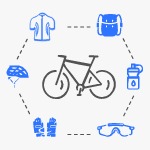
Riding Kit
If you’re bringing your own bike then,
- Bike
- Helmet
- Brake pads specific to your bike x 2 sets
- Rear mech hanger specific to your bike x 2
- Bottle of dry lube
- Four inner tubes, or spare bottles of fluid for
- tubeless tires (two for each tire)
- Quick link to suit your chain
- For 29” wheels bring extra spare tubes; these are more difficult to find in Nepal
If you are hiring a bike, the above equipment can be bought around Kathmandu, the charge of which will be extra.
Other than that, you will need the following riding kits:
- Bike gloves x 3 pairs
- Biking glasses
- Padded cycling shorts (to last at least 5 rides)
- Long-sleeved base layers
- Short-sleeved and long-sleeved cycling tops
- Biking socks (at least 5 pairs)
- Hat and non-biking gloves
- Head torch
Please note: If you’re bringing your own bike, you must make sure that you have it professionally serviced before the trip, and ask your bike shop to use dry lube on your chain.
General
- Four-season (zero degree) sleeping bag (We have rental sleeping bags available for an additional USD 35)
- Puffy down jacket (We have rental jackets available for an additional USD 35)
- Daypack (35-45 liters recommended) with rain cover
- Sleeping bag liner
Upper Body
- Sun hat or cap (We'll provide you with a free Ace the Himalaya baseball cap.)
- Knitted hat/Beanie
- Scarf/Neck Gaiter/Buff (highly recommended)
- Headlamp
- Sunglasses
Torso
- Technical fabric base layer (light for warmer months, heavy for colder months)
- Technical fabric short (2) and long sleeve (2) shirts
- Waterproof, windproof shell
- Fleece jacket or pullover
Lower Body
- Technical fabric base layer (light for warmer months, heavy for colder months)
- Hiking pants (2)
- Comfortable pants for inside the teahouses
- Waterproof, windproof shell
- Hiking shorts
Hands
- Wool or technical fabric liner gloves
- Hard-shell outer gloves (insulated for colder months)
Feet
- Wool or technical fabric warm socks
- Hiking socks
- Liner socks (optional such as silk)
- Trekking/hiking boots (waterproof recommended)
- Casual shoes
- Gaiters (lightweight for dust or heavy for snow in colder months)
Undergarments
Note: The quantity of each article of clothing can be adjusted to suit the preferences of each participant.
- Technical fabric/quick drying is best for underwear (opportunities to launder during the trip)
- Sports bras (women)
- Pajamas or sleeping clothes
First Aid Kits and Medications
- (Note: Guides carry medications and first aid kits during the trip. However, personal kits and medications are highly recommended.)
- Sunscreen
- Lip balm
- ointment
Other Essentials
- Passport
- Extra copies of passport-sized photos
- Reusable water bottle
- Toiletry kits
- Water purification tablets or UV water purifier (if you plan to treat water)
- Hydration bladder
- Towel
- Pillowcase
- Toilet paper (2 rolls)
- High protein snacks (such as protein bars or nuts)
- Waterproof/dry bags for carrying important documents and money
- Airline tickets (Please leave a copy at our office in Kathmandu. This can be useful if there is a change in the date of the flight.)
Optional
- Power bank or extra batteries
- Cameras and mobile phone
- Cards/book
- Binoculars
- Trekking poles
- Whistle
This list is only a guide. While you are required to bring everything on this list, there are numerous options, brands, and versions of each piece of equipment. Use your experience and the listed features to find the best gear for you. Some of the above equipments can be easily found in stores in Kathmandu for cheaper prices.
Trip Video
FAQs for Annapurna Circuit Biking
General
Why trek with Ace the Himalaya?
Ace has a reputation for successfully leading treks with knowledgeable leaders and staff taking care of all your travel needs. We are a certified sustainable travel company that also endorses the idea of giving back to the community by participating in various philanthropic activities. Here are 17 reasons why you should choose Ace the Himalaya for your next adventure!
Is Nepal open to travelers following the Covid-19 pandemic?
Indeed, Nepal is entirely open. Travelers are welcome in Nepal without any restrictions. Arriving travelers can obtain a visa on arrival at the Kathmandu airport as well.
What are the conditions to travel to Nepal post Covid-19?
Traveling to Nepal is now hassle-free. You don’t need a vaccination certificate or negative PCR test, but check with your airlines and transit countries for any specific requirements.
We suggest you look at the Nepal immigration site https://www.immigration.gov.np for the most up-to-date information.
What additional documents do I need?
- Two passport-sized photos (2×2 inch) to give to our office staff
- A copy of your international flight ticket to give to our office staff
- A copy of travel insurance to give to our office staff
What should I know about booking my flights to/from Nepal? Do I need to plan extra days in case of delays?
The best course of action is to add a day or two before and after your intended trek days in case of flight delays or cancellations. It also gives you time to buy clothing equipment and gear required before your trip.
Please be aware that Ace the Himalaya is not responsible for any inconveniences or missed international flights resulting from unforeseen events like airport changes, flight delays or cancellations, etc.
Can the guide speak English?
Yes, our guides can speak English. Most of them start their careers as porters and work for 3 to 4 years before becoming trekking guides. Their English skills are based on real-world experience rather than formal education. While they are able to communicate effectively, please note that English is not their first language, so their fluency may not be on par with native speakers. They will also assist with communication, especially since many locals, like shopkeepers and teahouse hosts, may not speak English.
What immunizations will I need?
- COVID-19 vaccination (Negative PCR report in case of unvaccinated travelers.)
- Typhoid vaccination is recommended but not required
We suggest you have a dental checkup before your trip and know your blood type. It is helpful if you inform us of any medical condition that is relevant so we may convey this information in the event of an emergency. Ace the Himalaya keeps your medical condition confidential unless treatment is necessary.
What type of bike is required for this trip and what brands are available for hire?
Either hard-tail or full suspension mountain bikes will do fine. In some parts of the routes, you can take downhill shortcuts for which we strongly recommend full suspension bikes. (Your guide will let you know if there are any shortcuts you can take.)
All the brands we provide are properly serviced and fully functional standard hardtail rentals best suited for the trips. We provide full-suspension bikes (if preferred by our clients) for an additional charge.
- Trek: 3-, 4-, 6- and 8-series
- Cube: Comp, LTD, CMPT, Reaction
- Giant: ATX, Tralon
- Other brands: Capic and V-Ket8
Can we hire bikes for the trip?
Yes, bikes can be hired at the time of booking. The bike’s frame size has to match your height, and since there is a limited number of each size, we strongly suggest you provide us with this information well ahead. In case of any damage incurred to the bike or the equipment, the client will be liable to pay for the repair and replacement, depending on the nature of the damage.
What equipment and tools are included with the bike hire?
We provide a helmet, a pump, a spare tube, a water bottle and a repair kit with a rental bike.
Can I bring my own bike and accessories?
Yes, it is highly recommended that you have your bike thoroughly serviced before coming on the trip. Spare parts are available in Kathmandu, but may not always be compatible with your bike.
Most airlines are quite used to people traveling with bikes, and if a bike is properly boxed and within the luggage allowance, it is a relatively hassle-free experience. On arrival at your destination, you will be met by your leader, and you will just need a baggage trolley to take your bike as far as the transfer vehicle.
Make sure the bikes are properly packed. You may do it yourself (here’s a guide or if you’re not sure, you could have a local bike shop pack it for you).
We take every care to ensure your bike is well treated, but it is normal for a bike to sustain minor scratches, resulting during the daily ride as well as loading and unloading from support/transport vehicles.
What is the procedure of checking in with a bike and what luggage weight allowance do I have?
Your bike is part of your baggage allowance on the plane, details of which are shown on your flight ticket, and maximum weights are usually between 20 and 25 kgs. A boxed bike weighs around 16 kg, so you need to pack carefully. Put heavy items in your hand baggage, wear your heavy/bulky jacket when you check in. Ace the Himalaya will not be liable for any excess baggage charges brought by the airline as a result of your exceeding the baggage allowance, whether you have a hire bike or take your own bike. In practice, excess luggage charges are rare for those who pack sensibly, even if you are a little over the specified limit.
Few airlines impose specific standard bike carriage charges. All such charges are beyond our control, and to be paid by the client. Where we know of a bike carriage charge in advance, this will be added to the relevant trip notes. In the unlikely event of any of your luggage and or bike being misplaced or damaged while in the care of the airline, a Property Irregularity Report (PIR) must be filed with the appropriate airline on arrival. This is essential if you subsequently wish to make a claim against the airline or on your travel insurance. This must be done at the airport where your baggage arrived or should have arrived.
Are there any bike maintenance and repairs while on the trip?
The support vehicle (where available) and the guide will carry the required repair tools and spares. We do recommend you carry some basic tools and spares (like a puncture kit and Allen keys). Our guides are also qualified mechanics and have ample experience maintaining bikes on the trips.
What cycling gear do I need?
Safety and comfort are what you’re looking for here. Here’s a quick list of what you’ll need for the trip:
- Cycling helmet (included with the bike rent)
- Touring shoes
- Cycling gloves
- Cycling shorts (1 to 3 pair)
- Socks – wool or synthetic (2 or 3 pair)
- Leg warmers or tights for riding
- Short-sleeved shirts (2)
- Light, long-sleeved shirt for layering and sun protection
- Windcheater, rain gear, jacket and pants
- Waterproof shoe covers
It is recommended that you carry a backpack with your valuables like camera and passport. Panniers are not suitable for the trips.
Can I bring my own saddle and pedals?
Yes. All the bikes are compatible with customized bike parts. The support team accompanying the group will be able help with any bike alterations or damage to the bike along the entire trip. Please inform us in advance if you plan to bring your own saddle and pedals.
Weather and Temperature
What is the best season for this trip?
The best time for the Annapurna Circuit Mountain Biking is from March to May and from September to November. It is not very advisable to bike during the monsoon season from June to August except for Lhasa to Kathmandu mountain biking.
Arrival and Visas
Is it possible to obtain a visa for Nepal upon arrival at the airport?
Yes, you can obtain a Nepal visa upon your arrival at the airport. There are kiosks in the arrival hall that you use to complete the necessary forms. The cost is USD 30 for a 15-day tourist visa, including numerous entries, or USD 50 and USD 125 for a 30-day or 90-day tourist visa including numerous entries respectively. You should carry cash (USD) with you to pay your visa fees quickly and easily, as digital payments are frequently unavailable.
To save time, we recommend filling out the online visa application form in advance. Applying online 2 weeks before your arrival will expedite the process at the airport. For detailed guidelines, please refer to our blog titled Guidelines for Online Tourist Visa Form in Nepal.
Who will come to pick me up at the airport upon my arrival?
Our staff will be waiting for you outside the airport terminal with our signboard (Ace the Himalaya). You will be accompanied to a hotel in a private tourist vehicle.
Payments and Extra Costs
How much additional money do I need per day?
It depends on your spending habits. Generally, in Kathmandu and Pokhara, you can allocate USD 20 for a lunch and a dinner. USD 7 to 10 a day will be enough to buy bottles of water, chocolates and a few drinks during the trekking.
Is it possible to use credit cards in the places I visit during the biking trip
In Kathmandu and Pokhara, yes – to some extent. Once you are out of the cities, all you need is cash. Please change the currency to local Nepali Rupees before you go to the mountains.
Is it possible to reserve a trip now and pay a deposit later, or do I have to pay a deposit at booking/reservation?
When you book, you must pay a 30% deposit to secure your itinerary. The remaining balance can be paid upon your arrival at Kathmandu or before arrival. US Dollars cash and credit cards (Visa, Master, and American Express) are accepted once in Nepal. Please note a 4% transaction fee will be added for all credit card transactions.
How do I pay the remainder of my balance upon arrival in Kathmandu? US Dollars cash or credit card?
You can make payments via US Dollars cash or credit card (Visa, Master, and American Express). A 4% transaction fee is added if paying with a credit card. Thus, we encourage you to pay with USD cash if you are planning to pay upon your arrival in Kathmandu.
We prefer you pay with larger bills (USD 50 or 100). Please note that the cash should not be older than 2009 and in good condition, as banks do not accept worn, torn, or crumpled bills.
How are the ATM and money exchange facilities in Kathmandu?
There are ATM and money exchange facilities almost every few meters in Thamel, where you will be staying in Kathmandu. So, you can easily use your cards to cash out limited sum of money to which a minimum charge is deducted by the ATM facility itself. You can easily exchange your foreign currencies in currency exchange centers for an exact rate.
Physical Fitness
How fit do I need to be for this biking trip? Is this trip for me?
The Annapurna Circuit Mountain Biking Trip should only be undertaken by those with some previous mountain biking experience. You should be physically fit to brave the effects of higher altitudes as you ascend over 5,000 m which involves some steep climbing against headwinds. Biking at this level lasts for several weeks. The Annapurna Circuit mountain biking is a spectacular trip in this category and gives you the possibility of staying in well-developed tea houses. A gradual ascent through a green river alley will lead you up to a number of high passes, where you will reach an altitude of 5,416 m at the Thorung-La Pass. This strenuous trip will give you a close insight into the traditional Nepalese culture.
Do we need to be experienced cyclists for longer tours?
No. The guide will carefully pace the ride to include rest and refreshment along the way. Where available, the support vehicle will accompany you and you can always hitch a ride if you need a break.
Preparation and Packing
What are the procedures after I make my deposit?
After making the deposit, one of our staff will email you for further information. We will require a copy of your passport photo page and your arrival/departure flight details. We will also provide you with additional trip information.
What sort of insurance do I need? How can I obtain a policy?
Travel insurance is mandatory for our hiking itineraries. We require your policy to have medical evacuation coverage for the maximum elevation of your itinerary. Insurance may also cover additional costs in the event of a flight delay or cancellation caused by bad weather, medical costs, theft, loss, and damage to your items while traveling. Travel insurance can be obtained online by one of several travel insurance companies. Please note that insurance obtained from an airline at the time of booking your flight may not cover medical evacuation coverage.
What are the necessary items that I should pack for my trip?
You can find the necessary items to pack for the trip on the Equipment section. Gear and equipment can be bought or rented upon your arrival in Kathmandu. If you plan on buying or renting gear in Kathmandu, please allow extra time.
What about my passport, medications, and belongings?
Bring copies of your passport, insurance papers, and other essential items in your carry-on during your flight. If you need to take medications daily, keep them in your daypack with your other essential possessions. You can store other non-trekking essentials in the office of Ace the Himalaya or at the hotel in Kathmandu.
Do you use porters on the trek or do we carry all of our own gear?
Whilst on the trek, our porter will take care of your luggage. All you need to carry is your small day bag for your personal belongings like camera, water bottle, sun cream etc.
Accommodation
What sort of accommodation can I expect in Kathmandu, Pokhara and along the biking route?
We use standard rooms at 3-star hotels in Kathmandu and Pokhara with breakfast included.
Along the biking route, teahouses/lodges generally provide basic clean facilities with a bed and a blanket. We can also offer you Ace the Himalaya sleeping bag and down jacket if needed (to be returned after the trip) but it is a good idea to always have your own sleeping equipment. We usually provide single and double rooms, and occasionally a dormitory. In tea houses, food will be prepared in the kitchen which you should not enter without permission. The toilet in tea houses provides essential and basic facilities and are always outside the room.
What sort of food can I expect in trekking?
Most of the teahouses (lodges) in the Annapurna Circuit biking trails cook a delicious range of mostly vegetarian fare. Pasta, tuna bakes, noodles, potatoes, eggs, dhal bhat, bread, soups, fresh vegetables (variety depends on the season), and even some desserts like apple pies, pancakes, and some interesting attempts at custard.
You will find a lot of garlic on the menu because it assists with acclimatization – eat some every day. In many larger villages, you may find some meat items on the menu. You can always get hot chocolate, tea, and hot lemon drinks, as well as soft drinks, and treats like chocolate and crisps. Each day dinner and breakfast will be at a lodge you’ll stay at while lunch will be taken on the way to the destination.
What is the drinking water facility in the mountains?
Bottled water is easily available at the lodges and teahouses, which you can buy at the cost of USD 1 at lower elevations to USD 4 at higher elevations per liter.
If you are planning to drink normal water all the way during the trek then, we use Katadyn filters to purify the natural water sources to make them safe to drink. This way, it is sustainable and pocket friendly as you need not buy bottled mineral water. You must carry a water bottle that can hold both hot and cold water and a hydration pack.
If the temperature drops too low for the Katadyn filter to function properly or if any technical issues occur, it is recommended to buy boiled water from the teahouse to ensure safe drinking water an alternative.
Can we get hot or boiled drinking water? Does it cost extra?
Yes, teahouses do provide hot boiled water for an extra charge of USD 2 to 5 per liter. The cost varies and increases at higher altitudes.
Can I shower/bathe during the trip?
At the lower altitude, the guesthouses provide the facilities of a hot shower.
And in the rest of the places (at higher elevations), warm water in the bucket will be provided for showering.
For all the above showers, it would cost you extra about USD 2-4 per shower. The higher you go the hot shower would be expensive.
Can I charge my digital camera or other equipment on my trip?
Yes, you can charge your equipment during the trek for an additional cost. The cost will vary but is around USD 1-5 per charge. Two pins (type C) and three pins (type D) adaptors are highly recommended. Bring these adaptors or purchase them while you are in Kathmandu.
Health and Safety
Do your guides have the trekking guide certificates from the Hotel Management and Tourism Center? Have they received first aid training for high altitudes?
We provide licensed trekking guides with fluent English. Our guides are certified by the Hotel Management and Tourism Center after receiving 45 days of training. Similarly, the guides receive high-altitude training from Kathmandu Environmental Education Project (KEEP).
What are safety measures in place? What safety equipment do your guides carry on the trek to deal with sickness/accidents?
Our guides are well trained and certified in first aid. Throughout the journey, our guides will evaluate your condition and your oxygen level using an oximeter. Our head office receives continuous updates on your condition and location through the guides. In places without a phone signal, your situation will be updated through a satellite phone during emergencies.
Is Ace the Himalaya's staff insured?
Our company insures all our trekking staff members, including guides, cooks, Sherpa, and porters. Please browse through our legal docment page to view insurance details.
What vaccinations will I need?
While no vaccinations are strictly mandatory for travel to Nepal, it is highly advisable to take precautionary measures to protect your health. To ensure a safe and enjoyable trip, we recommend the following vaccinations: Routine Vaccines, Malaria, Japanese Encephalitis, Hepatitis A, Hepatitis B, Typhoid, Rabies, Cholera, etc.
It is also helpful if you inform us of any medical condition that is relevant so we may convey this information in the event of an emergency. Ace the Himalaya keeps your medical condition confidential unless treatment is necessary.
What if I am very sick in the mountain?
Our guides are 24 hours available for services during the trek. They are trained to use first aid kits and have the knowledge to use Oxy meter. They are very much aware that the higher the altitude the oxygen level gets lesser so to get updated on the oxygen level of our clients and to know whether they are fit enough or need extra precautions to continue.
Guides carry local sim cards for both Nepal Telecom and Ncell in order to update the whereabouts and situation of every client. During times of emergency, our guides are alert and keep updated with the head office in Kathmandu which is available 24 /7 to arrange from horses to mules or helicopters in must-needed cases especially when the client is seriously sick in the mountain and needed to be hospitalized.
Practical Matters
Do I need to tip my guide and porters? How much would that be?
Tipping is expected and appreciated. You can tip your trekking guides and porters based on your satisfaction and enjoyment. We suggest you spend at least 10% of your total trek cost for tipping staff. You’ll learn more about how much to tip your group’s guides and porters during our pre-trip briefing in Kathmandu.
Is there a provision for a refund if I don't accomplish the trip?
Travelers occasionally fail to complete the journey for medical or personal reasons. In this situation, be aware that we do not issue any refunds for products purchased or unused trek days. We must pay our administration staffs, guides, and porters, purchase trekking permits, and all other booked accommodations in advance, so our expenses remain the same.
Who else will be joining my biking group?
If there are any, you will be allocated to a trekking group. The details of the personal data of your group members cannot be disclosed. However, feel free to contact us if you have queries about other trekkers in the group and we shall give you a general idea of the ages, nationalities, and sex of your group members. Chances are you will be trekking with others unless you have booked a private trip.
Are there any communication facilities during the trip?
Yes. The guides carry local cell phones, so you can use their cell phones if necessary and reimburse them. Assuming you have brought your cell phone, you can obtain a local SIM card and use it. Our guides or representatives can help you get a local SIM card after your arrival. There is the availability of Wi-Fi at most teahouses for an additional cost. We utilize satellite telephones for emergencies.
Can I add extra days to my trip?
You can extend your trekking trip for an additional cost. Potential arrangements will be made if we get a request from your guide. This is applicable for private or solo trips as the itinerary can be easily adjusted. The addition of extra days is bound by the time when you are in a group. Therefore, discuss with your group and guide, what changes can possibly be made.
I want to extend my holiday, any recommendations?
Yes, you can extend your holiday. Ace the Himalaya offers many options and alternatives for your holiday extension. For more information, you can visit our Day trips pages.
Transportation and Flights
Do I need to book my international flights for the travel to Nepal?
Yes, you must book your international flights. We are a local agency and do not make international flight arrangements. You can easily browse through flight tickets in airlines sites to book ones most feasible for you.
What mode of transportation do you use?
Depending on the nature of the travel, the transportation to and from the destination varies from domestic flights to vehicular transportation. We drive you to Besisahar, the starting point of the biking trip, and from Beni the end point of biking, a jeep ride will be offered to you and from Pokhara a tourist vehicle will bring you to Kathmandu. If you want to fly to Kathmandu, you can do so by paying extra amount. We provide you only those options which enhance your local experience while allowing you to bike comfortably and efficiently. We use private tourist vehicles for sightseeing, city tours and pickups. Depending on the group size we use cars, minibus or vans. For traveling along the narrow and bumpy roads of Nepal, we use 4WD and a private tourist vehicle. All the vehicles are usually air-conditioned unless we are traveling in cooler areas.
Traveler Reviews
These full and frank reviews are from travelers who have traveled with Ace the Himalaya previously. The reviews and experiences shown here are from reputable travel websites like TripAdvisor & Google.
 Google Reviews
Google Reviews
What makes this trip different ?
Our CSI with Sambhav Nepal
- Ace the Himalaya believes in giving back to the communities that surround and support tourism in Nepal. Ace provides logistical support and, if needed, cash donations to the projects of Sambhav Nepal (a local NGO).
- Sambhav Nepal and Ace work together to plan volunteer programs that will bring in foreign volunteers and make use of their enthusiasm, time, and talents in a variety of projects.
Sustainability and Responsible Tourism
- Of the few Travelife Certified companies in Nepal, Ace the Himalaya is one. We respect the procedures for sustainable tourism. Our excursions are socially and environmentally conscious, leaving the lowest possible impact in the Himalayas.
- About 80% of Ace the Himalaya’s staff members are natives of the regions where our trips are organized. It is one of our sustainable and responsible efforts to help local communities, support small businesses, and promote regional culture and way of life.
